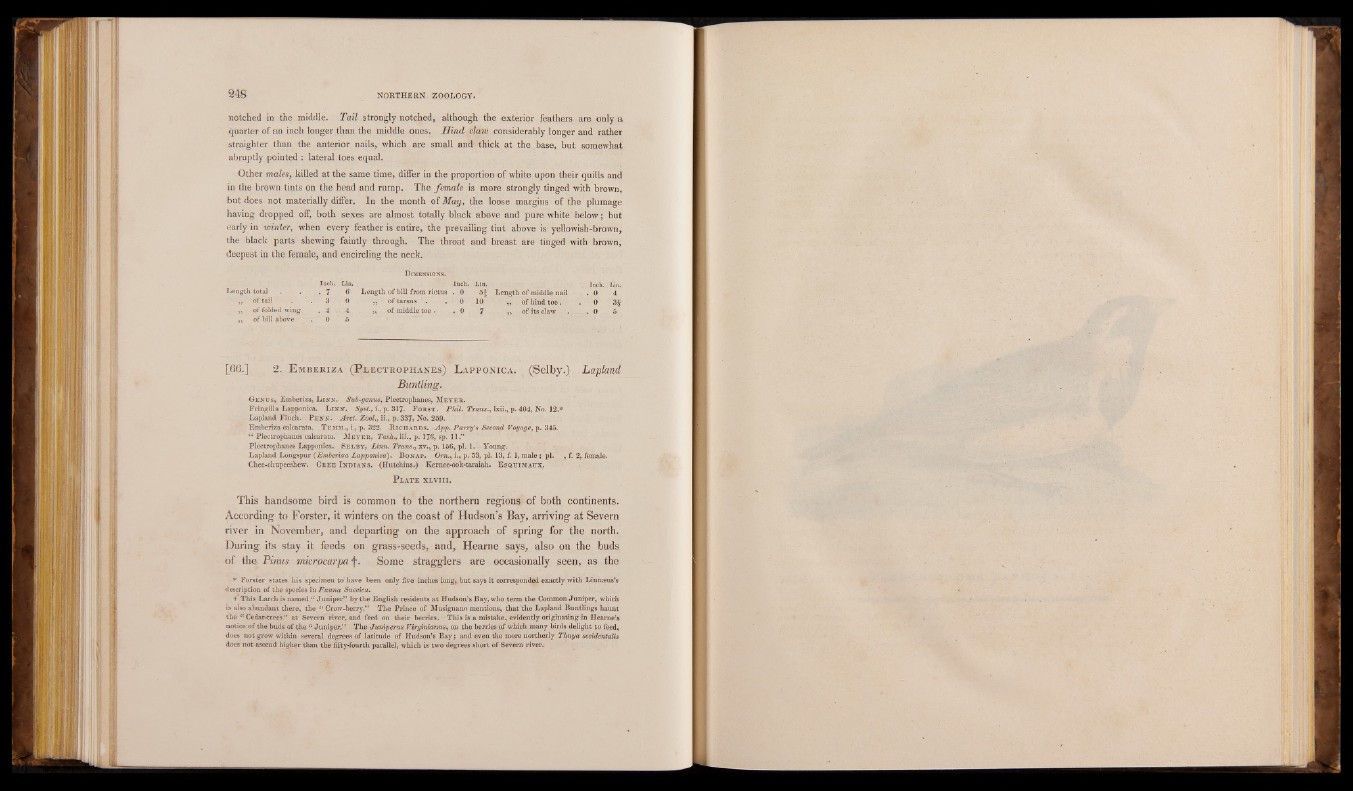
248 NORTHERN ZOOLOGY.
notched in the middle. Tail strongly notched, although the exterior feathers are only a
quarter of an inch longer than the middle ones. Hind claw considerably longer and rather
straighter than the anterior nails, which are small and thick at the base, but somewhat
abruptly pointed : lateral toes equal.
Other males, killed at the same time, differ in the proportion of white upon their quills and
in the brown tints on the head and rump. The female is more strongly tinged with brown,
but does not materially differ. In the month of May, the loose margins of the plumage
having dropped off, both sexes are almost totally black above and pure white below; but
early in winter, when every feather is entire, the prevailing tint above is yellowish-brown,
the black parts shewing faintly through. The throat and breast are tinged with brown,
deepest in the female, and encircling the neck.
DlHENSlONS. Inch. Lin. Length total Inch. Lin. Inch. . Lin. „ of tail . 7 6 Length of bill from rictus . 0 5§ Length of middle nail • o 4 . 3 0 „ of tarsus . 0 10 ,,i of hind toe. 0 3§ „ of folded wing . 4 .V 4 „ of middle toe . . 0 7 „ of its claw . _— 0 „ of bill above ~ T “ 0 5
[66.] 2. E mberiza (P lectrophanes) Lapponica. (Selby.) Lapland
Buntling.
Ge n u s , Emberiza, L in n . Sub-genus, Plectrophanes, Me y e r .
Fringilla Lapponica. L in n . Syst., i., p. 317; F o u st . Phil. Trans., Ixii., p. 404, No. 12.*
Lapland Finch. P e n n . Arct. Zool., ii., p. 337, No. 259.
Emberiza calcarata. Temm., i., p. 322. R ic h a r d s. App. Parry's Second Voyage, p. 345.
f ■ Plectrophanes calcarata. M e y e r , Task., iii., p. 176, sp. 11.”
Plectrophanes Lapponica, Se l b y , Linn. Trans., xv., p. 156, p l.l. Young.
Lapland Longspur (Emberiza Lapponica). B o na p. Ora,, i., p. 53, pi. 13, f. 1, male; pi. , f. 2, female.
Chee-chupeeshew. Cr e e I n d ia n s . (Hutchins.) Kemee-ook-taraiah. E sq u im a u x .
Plate xltiti.
This handsome bird is common to the northern regions of both continents.
According to Forster, it winters on the coast of Hudson’s Bay, arriving at Severn
river in November, and departing on the approach of spring for the north.
During its stay it feeds on grass-seeds, and, Hearne says, also on the buds
of the Pinus microcarpa •[. Some stragglers are occasionally seen, as the
* Forster states his specimen to have been only five inches long, but says it corresponded exactly with Linnaeus’s
description of the species-in Fauna Suecica.
t This Larch is named “ Juniper” bv the English residents at Hudson’s Bay, who term the Common Juniper, which
is also abundant there, the. “ Crow-berry.” The Prince of Musignano mentions, that'the Lapland Buntlings haunt
the “ Cedar-trees” at- Severn river, and feed on their berries.—This is a mistake, evidently originating in Hearne’s
notice of the buds of the “ Juniper.” The Juniperus Virginia/nus, on the berries of which many birds delight to feed,
does not grow within several degrees of latitude of Hudson’s Bay; and even the more northerly Thuya occidentalis
does' not ascend higher than the fifty-fourth parallel, which is two degrees short of Severn river.